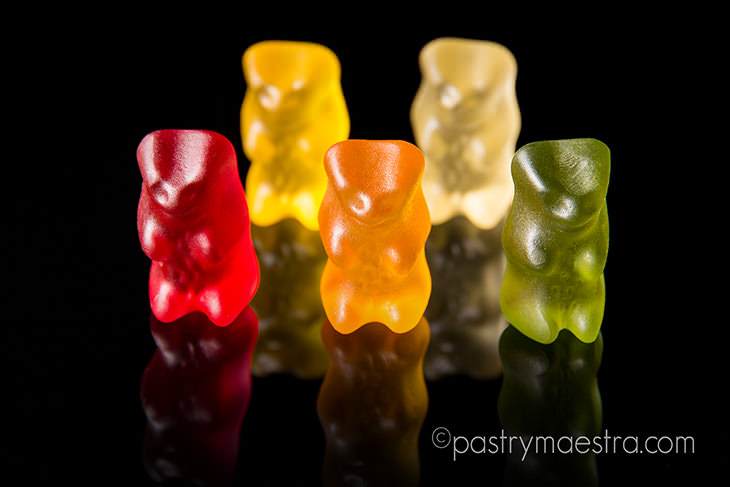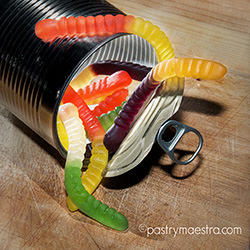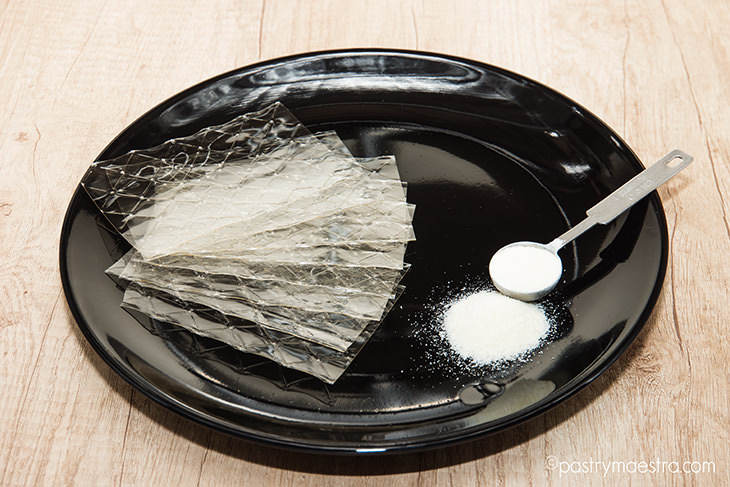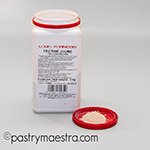

D
o you like gummy bears? I love all gummy stuff, except the sour ones. I know it is not the healthiest food in the world, but I really enjoy its chewy texture, various colors, and different flavors. I don’t eat them every day, of course, but every once in a while, I wonder out to the candy section of the supermarket and treat myself with a bag of cola bottles, jelly beans or gummy bears. The selection is so versatile that I often just look and study all the shapes, colorful combinations and different aromas. Anyway, when I get myself that gummy shot, I eat it all at once. Yeah, the whole bag. And when I finish it, I am fine until the next time because…it usually makes me sick. I know, weird. So what’s in those gummy bears that makes them so nice and chewy? It’s starch and gelatin, believe it or not! Now, let me tell you all about it.
Starch Thickeners
Starch based thickeners are fine, silky powders extracted from various plants and roots. They are usually used to thicken soups, sauces and creams. Starch thickens the liquid without affecting the taste too much, and without adding fat.
Corn Starch
Corn starch is a polysaccharide extracted from the endosperm of the corn grain. It is used for thickening soups and sauces, but it is also a very important ingredient in making pastry cream. In order to thicken, it must be first dissolved in a cold or lower temperature liquid, and then cooked for about 3 minutes. If you put corn starch directly into a hot liquid, it will lump. Corn starch works great with dairy based liquids, and when thickens, it produces opaque mixture. However, if used with acidic, fruit liquids, it retains starchy flavor when cooked. It is not recommendable to freeze creams thickened with corn starch because they break and change texture. The great thing is that corn starch is easily available; you can buy it in any supermarket.
Arrowroot Starch
Arrowroot starch is a fine, white powder made from tropical arrowroot plant. Like cornstarch, it has to be dissolved in cold water and then cooked. However, arrowroot is more sensitive, and it thickens the liquid into a glossy mixture at lower temperatures than corn starch does. Arrowroot starch has a gelatinization temperature of 64°C (147°F), and if heated on higher temperatures and too long, it will break down. Arrowroot becomes slimy when mixed with dairy liquids, but it tolerates acidic liquids better than corn starch.
Tapioka Starch
Tapioca starch or tapioca flour is a gluten-free starch extracted from the cassava root, the same root that we grind into cassava flour. It is available as a powder and in a form of pearls. Pearl tapioca has to be soaked in a cold liquid for several hours before cooking. Tapioca starch starts to thicken (gelatinize) at temperatures between 63°C and 84°C (145°F–193°F). It is recommended to mix tapioca starch with liquid ingredients before heating, and to leave it for 5-10 minutes to absorb the liquids. Tapioca makes shiny, translucent thick mixture, and it tolerates freezing very well.
Potato Starch
Potato Starch is a gluten-free starch extracted from potatoes. It is usually used for making noodles, potato chips, in instant soups, and in various gluten-free recipes. It can be used to thicken soups or gravies. When used in sponge cakes, it keeps the cake moist and makes it soft. Potato starch gelatinizes at relatively low temperature – 60°C (140°F).
Kudzu Powder
Kudzu powder or Kuzu root starch is extracted from the tuber of south Asian vine plant with Japanese name Kudzu. Kudzu is used in traditional Chinese medicine, and it showed some advantages in treating migraine and cluster headaches. Kudzu powder is first dissolved in a cold liquid, and then heated until it thickens and becomes transparent. Once thickened, kudzu doesn’t have starchy taste, it is translucent and it has smooth and gelatinous texture. It is not suitable for freezing, as it breaks down when thawed.
Wheat Starch
Wheat starch is the carbohydrate component that is left after processing wheat flour to remove the protein portion. It is used in making Chinese noodles, in pharmaceutical industry, and some European food manufactures even claim that wheat starch is gluten-free. Even though the protein is removed from wheat starch, it provides durability and elasticity to the dough.
Rice Starch
Rice starch is extracted from broken white rice. It is very fine, absorbent, and digestible gluten-free starch. There are three types of rice starch:
- Non waxy rice starch that forms gel when boiled and cooled.
- Waxy rice starch has creamy texture, and it is stable when frozen and thawed.
- Modified rice starch is popular as a substitute for gelatin.
Other Thickeners
Gelatin
Gelatin is translucent, colorless, brittle, flavorless solid substance made from collagen. Collagen is derived from the bones and skin of animals, in most cases pork. Since lots of people don’t eat pork due to religious reasons, gelatin is also produced from fish and beef.
It is available in sheets (leaf gelatin) and in a form of powder. Before use, it should be bloomed – soaked in cold water until rehydrated. Bloom also signifies the strength of the gelatin; the higher the number-the strength of the gelatin is stronger. This test was invented by Oscar Bloom, and it is also named after him.

Grades of gelatin:
- Bronze grade (bloom 130)
- Silver grade (bloom 160)
- Gold grade (bloom 200)
- Platinum grade (bloom 230)
You can substitute the same weights of sheet and powdered gelatin, as long as they have the same strength. Leaf gelatin should be soaked in a generous amount of cold water, and it should be well drained after blooming. If you are using powdered gelatin, the amount of cold water should be 4 or 5 times the weight of gelatin, and you don’t drain it. After blooming, gelatin should be dissolved in a hot liquid, but never boiled, because-if boiled-gelatin looses its ability to set.
Certain tropical fruits, such as pineapple and kiwi, have enzyme bromelin, which can prevent gelatin to set. Boiling those fruits destroys the enzyme, and allows gelatin to set.
Agar Agar
Agar (also known as Agar-agar, Ceylon moss or Kanten) is a gelatinous substance derived from red algae. It has been used for many years as an ingredient in desserts throughout Asia. Now it is used as vegetarian gelatin substitute, laxative (in larger amounts), and thickener for soups, for fruit preserves and in ice cream.
In order to make a jelly, agar is boiled in liquid until dissolved. It sets on a higher temperature and more firmly than gelatin.
Pectin
Pectin is a natural thickener, extracted from fruits, usually apples or citrus fruits, and it is used to thicken fruit preserves, jams and jellies. There are two main types of pectin sold for pastry purposes: yellow pectin and NH pectin.

Yellow pectin is a slow set, non-reversible gelling agent. It is usually mixed with other dry ingredients, such as sugar, and then added to a fruit puree or other liquid. You need to stir the mixture while heating until it thickens. Yellow pectin needs an acid in order to set, so if the liquid itself isn’t acidic, the recipe usually calls for some lemon juice or tartaric acid.
NH pectin is thermo reversible gelling agent. It is usually used for making cake glazes, jams and other fruit preparations. This form of pectin needs presence of calcium in order to jellify. NH pectin also needs to be mixed with other dry ingredients to prevent it from forming lumps. Then you should add it to the liquid and stir until everything dissolves. NH pectin starts to gelatinize at 80°C (176°F), and it forms clear, transparent thermo reversible gel that is fully set after 24 h.
Now, if after all this talk about starches and gelatins you don’t crave those yummy gummy bears, I can only admire your willpower because my hand is already reaching in the bag…Mmmmh, starch, gelatin, sugar, flavoring, it’ all there! Ah, the satisfaction derived from guilty pleasures can’t be beaten, no sir! As I already said, there’s no harm if you pop a few of those into your mouth every now and then, but you shouldn’t do that on a regular bases. Since now you know everything about thickeners, it would be much better if you make some homemade jam, pudding, cream or even your own pâte de fruit jellies yourself, right? Enjoy!



